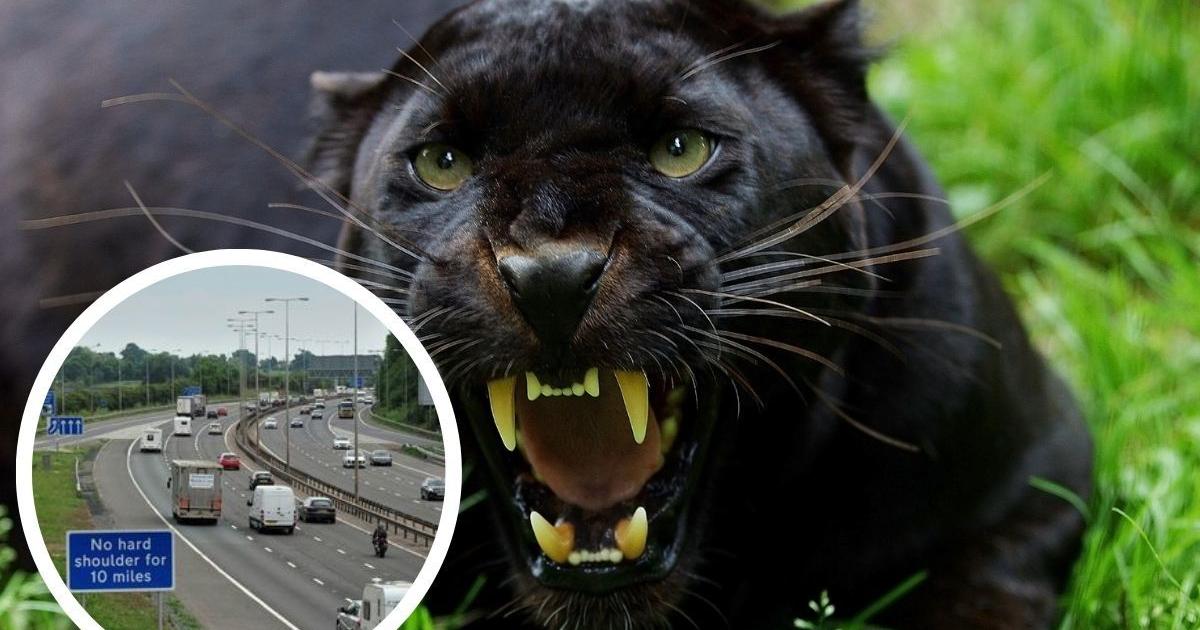The sighting in south Gloucestershire is being probed by big cat expert Rick Minter, who says a nearby farmer reported that cattle had been behaving nervously at the time for several days.
A driver spotted the ‘panther’ on the western side of the M5/M4 junction in May – leading to claims that our motorway verges may be a strangely attractive area for big cats believed to be living in the British countryside.
“In May a driver claimed to have seen a black panther lurking in the scrub by the M5 motorway verge in south Gloucestershire,” said environmental consultant Rick, author of Big Cats: Facing Britain’s Wild Predators.
Cattle scared by ‘prowling beast’
“In following it up I found that the neighbouring farm at that spot reported that its cattle had been on edge and were behaving nervously for a few days around the time of the slighting.”
In recent years there have been two other ‘credible’ sightings by motorists who have seen beasts resting on the verge of the M5 between Gloucester and Thornbury, added Rick.
Despite the noise and obvious disruption, he believes our motorway verges may actually attract big cats.
“A motorway verge may be noisy but for a large predator it could be an undisturbed zone with sun traps for resting,” he explained.
Motorway verge perfect for predator cats
“The scrubby vegetation acts as a wildlife corridor with rabbits and deer available as a ready food source.
“So big cats may use motorway edges as routes and refuges at times like other mammals do.”
Rick, who hosts the Big Cat Conversations podcast, explained that despite regular sightings, it can be hard to capture footage of the elusive creatures.
“People often put trail cameras on land where such incidents occur but with territories of 20 square miles or more, and being active more in the dark, these stealth predators are a challenge to film,” he said.
New exhibition shows big cat evidence
Rick revealed the M5 sighting ahead of an exhibition inspired by big cats which he is curating and which opens in Gloucestershire this week.
Depicting Britain’s Beasts: the art of British big cats at the Nature in Art gallery near Gloucester from Tuesday, August 12 to Friday, August 22, will showcase various art forms depicting the black leopards, mountain lions and lynx reportedly seen across the country .
The event is being run in association with Rick’s Big Cat Conversations podcast, which has heard about several close encounters from walkers in the Stroud and south Gloucestershire area.
Creature was hunkered down and stalking deer
“Episode 71 included a witness who unwittingly disturbed a black panther hunkered down watching roe deer just north of Stroud,” said Rick.
“He noticed an orange hue to the animals’ otherwise dark fur, suggesting it was a leopard in its black form, which most of the credible ‘panther’ sightings would seem to be.
“One of the illustrations at the Nature in Art exhibition shows the orange highlights of a black leopard, which can sometimes be noticed when the animal is lit up in sunlight.
Panther cornered fox
“Episode 41 features a dog walker near Tetbury who watched a black panther cornering a fox at dusk.
“Her three big dogs were on leads but they rumbled the cat, which rushed away and the fox emerged from its trapped situation and left the area keeping close to the walker and her dogs, seemingly wanting their company for safe escort.”
Rick believes that sightings and DNA evidence suggest that large cats such as leopards, panthers, pumas and lynx are breeding in Britain.
Numerous sightings have been reported across the UK for decades.
And recently tests from a sheep carcass found in Gloucestershire showed evidence of leopard DNA.
‘Trophy pets’ now breeding
Experts believe predators kept as ‘trophy pets’ were released from stately homes and following the 1976 Dangerous Wild Animals Act and have bred in the countryside.
The Nature in Art exhibition will explore the existence of these large felines in the UK, supported by DNA findings and tooth impressions on bones.
The collection will also display artwork, sculptures and poetry inspired by reported encounters with large cats.
Visitors will have the opportunity to view different forms of artwork, including book illustrations, modern posters and food and beer brand images.
Reconstructions sightings
The collection also includes people’s own reconstructions of scenes they have witnessed.
All artworks portray the big cats in British settings, such as woods or farmland, with other forms of art on show including wood and bronze sculptures plus poems and limericks celebrating these secretive predators.
Each day, visitors will have the opportunity to speak with witnesses about their experiences.
“It’s splendid to see Nature in Art hosting this aspect of Britain’s hidden wildlife,” said Rick.
“Large predators have always been represented in the art and culture of their lands, and now this is happening in Britain as well.
“Art can help our awareness of these stealthy large cats that are now culling deer.
“No doubt they mainly originate from discarded trophy pets but they now seem to be playing their part as predators in the ecosystem, and moving some people to illustrate them.
Bones show big cat tooth marks
“Among other things the exhibition showcases the big cats’ feeding habits on natural prey like deer with tooth marks on bones as evidence.
“Some of the samples of prey bones will be at the exhibition, along with artist illustrations showing how big cats consume prey and leave the distinct tooth marks.”
Have you spotted a big cat or seen evidence such as a suspicious carcass?
Email Rick at rick@bigcatconversations.com
Depicting Britain’s Beasts: the art of British big cats runs from Tuesday, August 12 to Friday, August 22.
Nature in Art is at Wallsworth Hall off the A38 at Twigworth, Gloucester (GL2 9PA)
